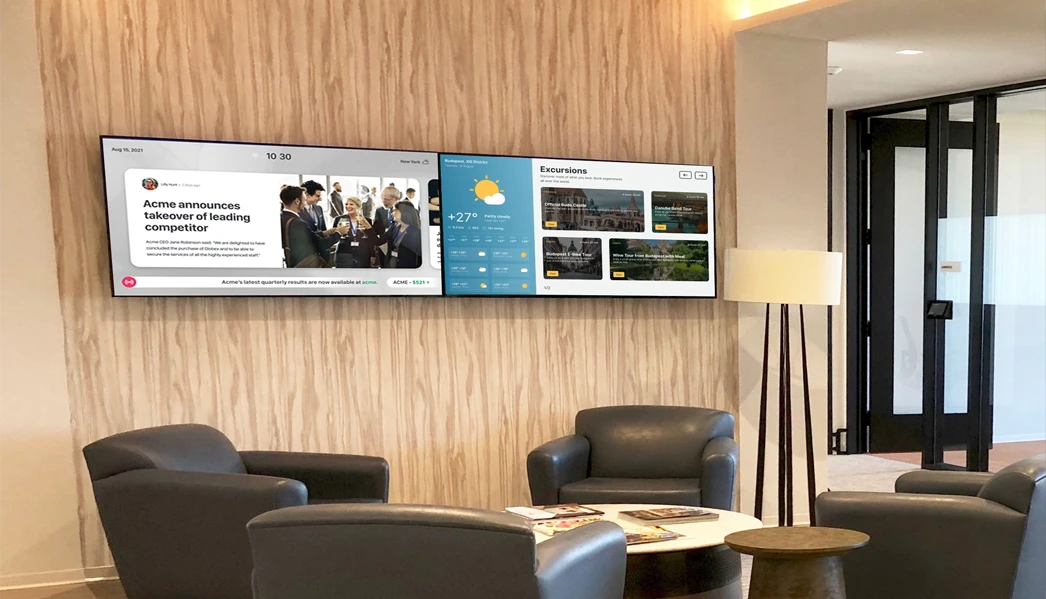In the competitive business world today, proper communication equals success. Digital signage is increasingly being used in the corporate space, serving as a new and powerful way to channel information in the workplace, achieve improved employee engagement, and establish identity. What primarily used to be a retail and advertising tool has now found immense prominence in the corporate sector, with quite a few varied advantages that generally culminate into more connected workplaces and greater productivity.
What is Digital Signage?
Digital signage involves the use of digital displays like LED and LCD monitors or projection systems to carry information in a dynamic and exciting way visually. In businesses, this means the information, or messages can be carefully placed in lobbies, meeting rooms, break areas, and hallways to pass across important information, announcements, or updates.
Key Benefits of Digital Signage in Corporate Offices
Improved Internal Communication: In the corporate office, digital signage proves to be a wonderful way of carrying forward messages throughout the workspace. This may include company news, updates on policies, or other important messages that must be communicated fast; all this can be communicated in real-time through digital signage.
Improved Employee Engagement: Keeping employees engaged is a key aspect of productivity and morale. Digital signage can be used to showcase employee achievements, birthdays, anniversaries, and other important milestones, which can bring the community together and boost recognition. Also, it can present motivational quotes, company values, and success stories that would keep inspiring and motivating the workforce.
Streamlined Meeting Management: It is always a hassle to schedule meeting rooms and manage them, but digital signage makes it easier. Interactive displays outside the meeting room will showcase the availability of the room, further meetings, and even accept on-the-spot booking. So scheduling conflict is reduced, and there is maximum use of space assigned for meetings.
Reinforcement of Brand Identity: All this repetition through digital signage helps to reinforce a company’s brand identity across an office space. In this way, through the use of branded content, corporate color schemes, logos, and company messages, businesses provide a homogeneous display that matches their corporate culture and value.
Visitor Experience Enhancement: First impressions count and digital signage can go a long way to help create a welcoming atmosphere for visitors. In lobbies and reception areas, it can provide directions, welcome messages, or even introduce the company’s history and values. This not only enhances the visitor experience but also reflects positively on the company’s professionalism.
Real-Time Data and Analytics Display: In today’s data-driven world, access to and the real-time display of data can be seen as a big plus. Business intelligence can be channeled onto digital signs to display live dashboards, sales metrics, key performance indicators, and other important data that would keep staff and management up-to-date with issues at hand in order to make timely data-driven decisions.
Cost-Effective and Sustainable Solution: For sure, investment in digital signage upfront can be high. In the long run, however, it is a cost-saving system. Printed materials, including posters and flyers, have to be updated continually and hence reprinted continuously, so they form part of a paper budget that continually renews itself. Digital signage doesn’t use up any of the other means of information; therefore, it helps in avoiding further environmental costs.
Best Practices for Implementing Digital Signage in Corporate Offices:
Content Relevance and Freshness: The effectiveness of digital signage has high dependency on content relevance and freshness. Keep the contents updated regularly with current affairs, company news, and any other information relevant to maintain interest as well as keep the employees informed.
Strategic Placement: How and where digital signage is placed can make a huge difference. Point to high-traffic areas where employees and visitors are likely to view the displays: entrances, elevators, and common areas. Be sure screens are positioned at eye level and easily visible.
Integration with Other Systems: Digital signage can be integrated with other corporate systems, such as calendars, HR tools, and data dashboards, among others, to provide more functionality. For instance, integration with the calendar of the organization can have the ability for display of meeting room schedules, whereas a link with HR systems can automatically update the content related to employee recognition.
Interactivity and Accessibility: The use of interactivity with the digital signage should be considered; it can easily be done through the use of touchscreens, QR codes, and mobile integration for accessibility and engagement. In ensuring that the content is accessible to all employees, including the disabled, it must adhere to the general accessibility standard.
Monitoring and Maintenance: Observe performance on digital signage systems at regular intervals to assure that they are working properly. Routine maintenance and scheduled routine maintenance prevent technical issues while maintaining the displays in optimal condition, including the review of content performance metrics for what works best with your audience.
For corporate offices, digital signage has become a very important tool to improve the communication process, elevate employee engagement, and strengthen brand identity. The application of digital signage in a workplace strategically by a company helps in making its workplace more connected, more efficient, and more engaging. As technology continues to improve, the scope of digital signage within corporate environments only stands to grow, offering new and inventive ways to connect, inform, and inspire.





